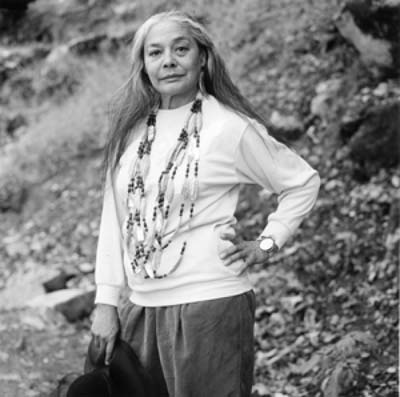
An Ohlone descendant from San Benito County continued working
alongside archeologists at a housing site Tuesday to ensure
culturally sensitive artifacts are protected, but it remains
unclear how the city of Santa Cruz and developer will resolve her
request not to build on the probable burial ground.
J.M. Brown
An Ohlone descendant from San Benito County continued working alongside archeologists at a housing site Tuesday to ensure culturally sensitive artifacts are protected, but it remains unclear how the city of Santa Cruz and developer will resolve her request not to build on the probable burial ground.
Bones believed to be that of a Native American child were discovered there in early August, sparking a demonstration over the weekend that resumed in front of the site Tuesday. Residents concerned about disturbing what they consider to be sacred ground are hoping the developer will stop building or in some other way protect the site.
Ann Marie Sayers, an Ohlone woman recognized as a most likely descendant through the California Native American Heritage Commission, has been monitoring archeological work at the site. The commission, which has custody of the remains, is responsible for preserving Native American grave sites.
“I would love to see (the land) purchased by people who understand what sacredness is,” she said Tuesday. “KB Homes should donate it to the city or the county so it would remain open and no more burials be disturbed.”
Sayers, who lives in San Benito County’s Indian Canyon down a dirt path off Cienega Road, said no other remains have been found, but tool-making debris has been uncovered.
Laws governing Native American sites don’t give Sayers the authority to stop work there. She can only make recommendations.
Juliana Rebagliati, the city’s planning director, said she could not discuss details about the discovery or specific steps the city and developer might take as a result of it because the matter is confidential under the law. Rebagliati said a monitoring plan was put in place for the site during the environmental review of the developer’s plans, once it was identified to have archeological significance.
“This was before any tree removal, soil disturbance or grading was allowed to begin,” Rebagliati said.
Since then, she said archaeologists have been on site monitoring construction, and city staff also have been overseeing the work.
“Reports I have received from all involved are that everything is going well, and care is being taken by KB Homes to allow appropriate direction and treatment by the archaeologists working on site and the most likely descendant,” Rebagliati said. “This oversight by the Native American representative and monitoring by archaeologists will continue for as long as any soil disturbing activity is occurring on site.”
KB Home has tightened security at the nine-acre site, which demonstrators accessed Sunday. The construction zone at Market Street and Isbel Drive was locked Tuesday, where it had been open Friday.
“We understand that there are questions regarding this property, but we are unable to provide details at this time,” spokesman Craig LeMessurier wrote in a statement. “KB Home will continue to work with the city of Santa Cruz, the Native American Heritage Commission and the certified third party archeologists to ensure that this situation continues to be handled properly.”
But Isbel Drive resident Sami Weiser, whose home is across the street from the site, said he wants to see the area remain as open land.
“You don’t build over a cemetery, if that’s what it is,” he said. “I wish they would stop construction, but I don’t know if that is going to happen.”
Isbel Drive resident Dan Lovejoy, who lives in the house next door to the archeological site, said, “My feeling is they should be respectful. They seem to be very careful at what they’re doing.”
John Malkin, also an Isbel Drive resident, marched with demonstrators Sunday and said he plans to stand with them outside the construction site this week.
“I’m curious to know what this land was and who lived here before,” he said, after a hike with son Bodhi, 4, on his back. Malkin said he would like to see the burial site be designated “a protected area that highlights the roots of this area.”









